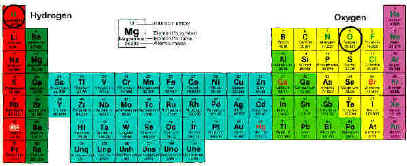Water is a chemical combination of
hydrogen and oxygen. Water is a colorless, odorless, and tasteless
substance. Point out hydrogen and oxygen on the periodic chart.
Ask the children if they know what hydrogen is. The element
hydrogen is a gas. Ask the students if they know what oxygen is.
The element oxygen is a gas. Water, therefore, is a combination of
two gases that form an entirely different substance and state of matter!
Water is very important to our everyday lives.
Emphasize to your students, because they are so familiar with water, that
they take it for granted. You may want to interject some environmental
concerns that
clean water is important for humans and most organisms to
survive.
Water is an important commodity to all organisms
that live on Earth. Although it appears as if we will never run out
of water, only 3% of all of the Earth's water is fresh (2/3 is locked up
as ice, 1/3 as groundwater, lakes, and atmosphere), 97% is salt water which
is unusable by most land organisms' metabolic systems.
Humans demand clean water. In some
areas there are more people than clean water. Methods to clean used
water are becoming more widespread. The end product is referred to as “recycled
water.” Instead of nature cleaning the water, humans have created
factories that accelerate cleaning the water. They use filtration,
chemical additions, disinfection, and microorganisms to clean water. The
term “recycled water” implies that water has been cleaned naturally or
by methods developed by people to reclaim water.
Water can be recycled for billions of years.
Once water is formed on Earth, it has the ability to change forms easily.
If water becomes dirty or polluted when it is a liquid, it can clean itself
through evaporation process, form a cloud, and then come back as clean
rain water.
PROCEDURE:
 Show students hydrogen and
oxygen on the periodic table of the elements. (they are circled in the diagram
to the right) Discuss that both are
gases, and when they join to make a compound it is a liquid at normal temperatures.
Show students hydrogen and
oxygen on the periodic table of the elements. (they are circled in the diagram
to the right) Discuss that both are
gases, and when they join to make a compound it is a liquid at normal temperatures.
Use the online interactive version of the periodic table if you
want to go over the different elements.
- Discuss the importance of clean water
for every organism on Earth. Bring out that water can be cleaned
by nature and also cleaned by humans through different methods.
- Read the online book called, "Giving Water a Second Chance,"
by J. R. Blueford. This book goes through the different stages of how
water is cleaned both naturally and by human developed methods.
- Use the worksheet as a coloring exercise to facilitate a discussion
on what happens to water that has been used in the past and how it is cleaned.
For instance the dinosaur is drinking water, but as all organisms, it must
come out. The dinosaurs will go to the bathroom, but nature will
naturally filter the liquid through different rocks and soil. It
will clean the water so it can be used again. This is nature's way
of recycling water.